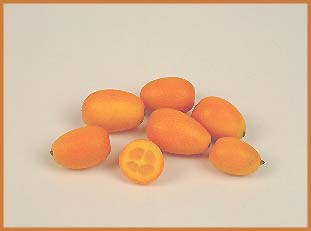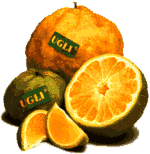Sweet Orange
Citrus sinenis
Family: Rutaceae
Clementine,
Mandarin, Tangerine,
Satsuma
Citrus reticulata,
Family: Rutaceae
Description
& storage
Orange:
Round thick skinned juicy edible fruit that is a reddish-yellow color
when ripe.
Mandarin
types: type of small orange with loose skin.
Store
them at 12 degrees Celcius (=57o F) or if you like in the refrigerator.
This is nice when you use them for squeezing.
Tree
Orange trees are
evergreen
trees. They grow 8 to 15 m. high.
The mandarin tree
grows up to
7,5 m. high.
The kumquat plant
is a shrub
that grows up to 4m. high.
Sweety: see grapefruits.
Short history
The orange is
cultivated over
thousands of years now. It is supposed to originate from South- and
indo-China.
The clergyman
Pierre Clement
crossed a mandarin and an orange and this luckily crossing
was a seedless
mandarin with
a looser skin thus easier to peel: the clementine. (beginning of the
20th
century).
The satsuma is a
special crossing
from Japan.
Use
Oranges are eaten by
hand
and squeezed a lot.
Mandarins are
eaten by hand
and can be used to squeeze as well. A great sweetner for grapefruit
juice.
Kumquats are eaten
raw withe
the edible skin,
Types
and family
Clementines:
the clementine
is a seedless mandarin.
Kumquats: the
kumquat
is like a citrus fruit and has an edible skin. It is the most well
known
of the sort fortunella which is closely related to Citrus.
Mandarins:
type
of small orange with loose skin. The mandarin got its name because it
was
exploited by high-ranking government officials in China (mandarins).
Minneolas:
are
a crossing between a tangerine and a grapefruit and can be recognized
by
"the
little nose". Can be peeled manually. Is a type of Tangelo, a minneola
is a specifically marketed tangelo.
Oranges:
There are different types of oranges: navel oranges, Valencia oranges
and
blood oranges are the most cultivated races.
Tangelos:
a tangelo is a crossing between a tangerine, a grapefruit and an
orange.
A specific kind of tangelo is the Ugli which is described further on
this
page.
Satsuma:is
a very special seedling from Japan. Its skin is a bit tighter than the
clementine
and it doesn't have seeds as well.
Tangerines:
a tangerine is an orange-red mandarin with a particular citrus taste.
Can
be peeled manually.
Uglis:
a
specific kind of tangelo, easier to peel. A crossing between a
tangerine,
a grapefruit and an orange. Looks really ugli and sometimes has brown
spots.
Can be peeled manually.
Other peculiar
characteristics
The calcium
in fortified orange juice is better absorbed than the calcium in milk.
A glass of milk (8 ounces) has 291 mg of calcium; of which 93 mg is
absorbed
(31%). Fortified orange juice (8 ounces) has 350 mg of calcium; of
which
130 mg. is absorbed (37%).
One
orange
contains about 50 mg. vitamin C; this is about 2/3 of our daily need;
Oranges
are an acid
and therefore a detoxifying
fruit;
Bitteroranges
can't be eaten raw and are used to make marmalades;
Citrus
fruit
is never colored artificially.
The
orange
colors orange under the influence of cold temperatures. In the tropics
the fruit keeps a green to green with yellow stains color.
Nutrition
Facts
Selection
Recipes
Acidity
 | |  |
| 
|
 |
|  |
| 